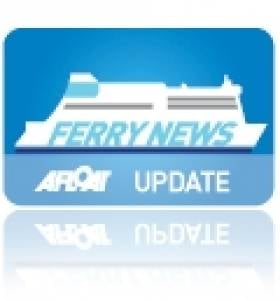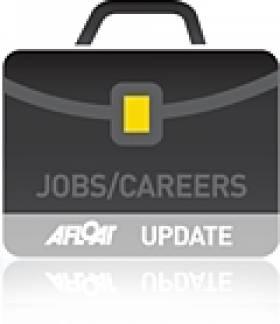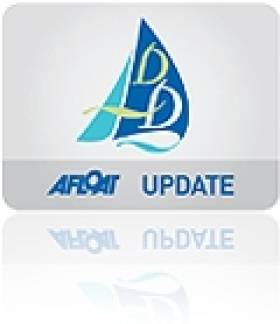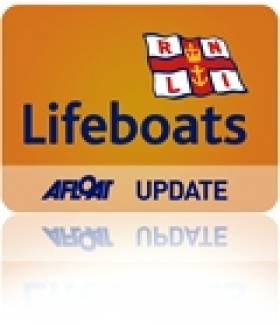Displaying items by tag: Cork Harbour
Outstanding Anthony O'Leary is Worthy Sailor of the Year
Anthony O'Leary of Cork is the Afloat.ie/Irish Independent "Sailor of the Year" in celebration of his outstanding achievements afloat nationally and internationally throughout last season, and to honour his dedication to sailing in all its forms both as a participant and an administrator.
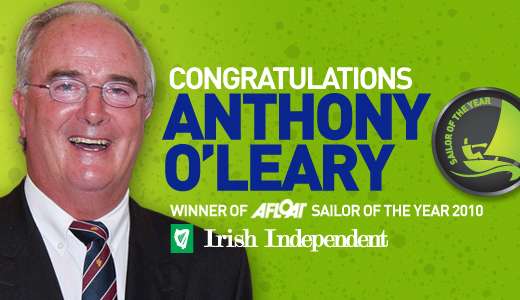
The O'Leary pace afloat and ashore belies his age of 53. During 2010, it was in May that he was "Sailor of the Month" for an already remarkable list of wins with his Ker 39 Antix. Having topped the April Series in Kinsale, he then won the Crosshaven-Dun Laoghaire race overall, went on to win his class and be one of the top points scorers in the ICRA Nationals in Dublin Bay, and then went on to Scotland to win his class overall with a nail biting brace of wins on the final day of the Scottish Series.
To achieve all that before May was out was exceptional, but the O'Leary progress was only beginning. The big picture was to maintain momentum towards the international Commodore's Cup in the Solent in August. Antix was one of the three boat squad, and her skipper was also the team captain in a campaign which was light years away from the glossy efforts which dominated the boom years of Irish affluence.

Anthony O'Leary takes on the waves at the helm of his yacht Antix during Cork week in Cork Harbour. Photo: Bob Bateman
In previous seasons, Ireland had been able to muster enough boats for two or even three teams, yet had never won despite being within inches of success. But this time round, only three boats were game for it, and only one – Rob Davis's Corby 36 Roxy – was new. Yet with Dave Dwyer's ever-keen Mills 39 marinerscove.ie filling the third slot, O'Leary headed a potent force, and he himself sailed with style and inspiring sportsmanship to give Ireland a commanding overall win.
Anthony O'Leary is the personification of Irish sailing at its very best. With the enthusiastic support of his wife Sally, he is father to a family which has logged outstanding sailing success at all levels. Yet he himself is in many ways the quintessential club sailor. He is as happy racing the Autumn series at Crosshaven with a 1720 or the West Cork regattas with a cruiser-racer, as he is competing at the highest levels. He has been among the front runners for the title of Ireland's "Sailor of the Year" several times. And now, as with all his wins, when he does do it, O'Leary does it with style.
Crosshaven Lifeboat Recover Body in Ringabella Bay
Crosshaven RNLI Lifeboat report that they have recovered the body of a missing fisherman from the sea at Ringabella Bay after information received from a person on shore. The fisherman was lost when the fishing boat sank almost four weeks ago.
Related Safety posts
RNLI Lifeboats in Ireland
Safety News
Rescue News from RNLI Lifeboats in Ireland
Coast Guard News from Ireland
Water Safety News from Ireland
Marine Casualty Investigation Board News
Marine Warnings
‘Proposed’ Cork-Spain Route Remains Under Review
In addition to services running out of Rosslare operated by Celtic Link Ferries and Irish Ferries and the alternative option of landbridge connections to Europe via the UK.
In the meantime, the Port of Cork will continue to be in dialogue with potential operators and investor's, however in the current climate it is proving more challenging to establish the service. Yet both the port authorities in Cork and Gijon remain committed in establishing the first direct Irish-Iberia passenger ferry route, with an update on the Spanish service due in early June.
Since 2008 the port authorities of Cork and Gijón, through the Promotion of Short Sea Shipping and Co-Operation with Small Medium Enterprise's (Proppose) an EU Inter-Reg project, have conducted feasibility studies into the service.
Interest in the service to date, has shown interest from Brittany Ferries, P&O Ferries and Transfennica, a Scandinavian based operator. It was envisaged that a ro-pax type of vessel would operate the 24-hour route to Gijón in Asturias, the region which forms part of Spain's northern 'Green' coast.
The route across the Bay of Biscay would be an attraction to freight hauliers, saving mileage and reduced fuel costs in addition avoiding a weekend ban to trucks travelling through France.
Last summer the ro-pax Norman Bridge started a new route between Nantes / St. Nazaire (Montoir-de-Bretagne) and Gijón, operated by GLD Atlantique. This route received support through the EU 'Motorways of the Seas' (MOS) programme to divert vehicle traffic from congested road-infrastructure and transferred to designated shipping routes, using larger and faster ro-pax vessels.
The route's opening was marked with a declaration signed by Dominique Bussereau, the French Minister of State responsible for Transport and his Spanish counterpart Magdalena Alvarez of the first of two Franco-Spanish MOS concept routes, starting with the 14-hour GLD Atlantique service.
- Irish Ferries
- port of Cork
- Celtic Link Ferries
- Fastnet Line
- P&O Ferries
- Brittany Ferries
- Ports and Shipping News
- Cork Harbour News
- RoPax
- Port of Gijón
- Proppose
- Motorways of the Seas
- MOS
- Transfennica
- CorkGijón
- Asturias
- 'Green'Spain
- Landbridge
- NantesSt.Nazaire
- GLD Atlantique
- Norman Bridge
- Cork Harbour
Rejig Means No South Coast Match Racing Fixtures
There will be no match racing on the south coast this year following a rejig of the fixtures calendar.
After two years of expansion for match racing in terms of events the theme for 2011 is consolidation.
Changes to the ISA SailFleet schedule for the boats mean that we have had to go through a rejigging of the match racing calendar.
The major impact is that Royal Cork YC are to take the boats latter than originally hoped meaning that they will be unable to host a leg of the Tour.
With Kinsale not taking part in the SailFleet scheme this year that means no match racing on the south coast for the first time in a couple of years.
With no tie up with the Dun Laoghaire Festival of Cultures available this year a date of July 23rd and 24th has been settled on for the Ireland vs The World International.
The highlight of last year this event will once again pit Irelands 6 best match racers against 6 teams from the rest of the world. Once again National and Tour champion John Sheehy will captain the Irish team.
The Leinster Match Racing Open, to be hosted by the Royal Irish Yacht Club, has been moved to July 16th and 17th to allow it to act as qualification for the Irish team for the following weekend and to give Laura Dillion and the Gladiators (Sam Hunt, Paddy Blackley, Peter Bayly, Richard Murphy) competitive practice immediately before heading over to Poland to represent the country at the ISAF Nations Cup.
Howth Yacht Club's, Dublin Match Racing Open stays with a date of September 3rd and 4th before we head for Lough Derg and the Womens (October 15th and 16th) and Open National Championships (November 5th And 6th).
All of the above means that here will be no Munster Match Racing Open this year and work continues to find a host for the IUSA Student Match Racing Nationals with Galway a potential for early April. There has been considerable work on the cost of entry for events over the winter and the majority of events will have a basic entry of €330 this year. All events will be run at ISAF grade 3.
Revised calendar
July 16-17th – Leinster Match Racing Open, Royal Irish Yacht Club
July 23-24th – Ireland vs The World International, Royal St George Yacht Club
September 3rd and 4th – Dublin Match Racing Open, Howth Yacht Club
October 15th and 16th - Womens Match Racing Championships, Lough Derg Yacht Club
November 5th and 6th – National Match Racing Championships, Lough Derg Yacht Club
Royal Cork Seek Operations Manager
The Royal Cork Yacht Club is recruiting an Operations Manager on a fixed term contract basis.
The Club offers a full range of sailing facilities, comprising a 200 berth marina, 40 moorings, extensive dinghy facilities, seven-day hospitality service and a full 12-month schedule of sailing activities.
Operating from Crosshaven, Co. Cork, the Royal Cork Yacht Club celebrates the 300th anniversary of its founding in 2020.
A notice on the club website this afternoon says;
"We are seeking to recruit a senior individual who will provide overall leadership and management for our operations team, with responsibility for overseeing the Club facilities, hospitality services and sailing activities. He or she will also be involved in the advancement of the Club's ongoing infrastructural development plan.
Reporting to the Executive Committee, this is an exciting opportunity for a person with proven commercial, hospitality and marketing skills.
The person appointed will have senior management experience, preferably in a marine, or leisure environment, and must be able to demonstrate strong interpersonal, organisational and leadership capacities."
Please send applications and CV (by e-mail only) to [email protected]
Cork Clipper Brings €5.6m in Economic Return to the Local Economy
An economic impact analysis was carried out by three MBS students from University College Cork (Ger Swayne, Lorcan Daly & Stephen Hicks) which reported an economic impact of €5.6m with accommodation and food and beverage accounting for 65% of the figure. The students worked according to the standard Failte Ireland festival report methodology which includes qualitative and quantitative research.
At today's launch Deputy Mayor Of County Cork Cllr John O Sullivan stated 'the festival gave a great boost to the Kinsale area early in the summer season and it also ensured that works were carried out in the town prior to the event that benefitted both locals and visitors. In particular the refurbishment of the Old Mill as an exhibition venue was a huge new resource for the town.'
The media report was carried out by IFM Sports Marketing Surveys and was commissioned by Clipper Ventures who run the Clipper Round the World Yacht Race. Global media coverage for the whole race is estimated at over $100m and Cork's share of this is very substantial at $26.5m. These figures are boosted by a Discovery Channel global deal that has been agreed with the TV series producers and Clipper Ventures. An Irish broadcaster for the series will be announced in the coming weeks.
Commenting on today's results, Fiona Buckley, Head of Operations, Fáilte Ireland stated 'from a tourism perspective the media coverage that Kinsale, Cork and the region received through the Clipper project will ensure that Cork is top of mind as a tourism destination in the coming years. In addition the economic report found that 98% of the overseas visitors would return to Cork as a result of the Clipper festival and 97% would recommend Cork to their friends.'
The festival in Kinsale was helped by the arrival of the fleet of 10 Clipper yachts six days ahead of schedule and the fantastic weather during that period. When the yachts moved to the new Port of Cork Marina on 07 July the weather changed dramatically and this had an impact on the attendance figures in the city.
'When the fleet arrived in Cork city there was a crowd of over 10,000 people to welcome the fleet to the new Cork City Marina which was installed to welcome the Race but is also a lasting legacy to marine tourism in the region. We would like to thank the Port of Cork for investing in this new permanent infrastructure with the support of Cork City Council.
This new Marina will play host to other marine events over the coming years.' Stated Lord Mayor Cllr Michael O Connell Clipper Race Chairman, Sir Robin Knox-Johnston, said, "Cork and Kinsale were fantastic hosts, providing marvellous entertainment during
the race festivals in both locations and I am pleased to see that they reaped the rewards. The welcome visitors received will ensure a lasting tourism legacy for years to come. "
The return on investment for the project is estimated at over 300% which is above average for hosting a sporting event of this calibre.
Dun Laoghaire to Dingle Race 2011 is Launched
The possibility of an Open 40 entry plus a new white sail division are just some of the developments for the tenth Dingle Skellig Hotel Dun Laoghaire to Dingle Race. Over 50 (SCROLL DOWN FOR PHOTOS BY MICHAEL CHESTER) gathered at the National YC in Dun Laoghaire last night to hear local TD and the Minister for Sport, Tourism and Culture Mary Hanafin give a ringing endorsement for the unique 320-mile offshore race when it sets sail on June 11th. A notice of race and entry form is available for download below.
The last race attracted 39 entries and a course record was set by Michael Cotter's Whisper. This year organisers Martin Crotty and Brian Barry along with Dingle Harbour master Brian Farrell are confident that they will break the 40 boat barrier. They may well be right as the event has been specifically timed to bring Dublin boats to the south coast for ten days of racing at the ICRA Nationals in Cork Harbour and the Sovereigns Cup the following week in Kinsale.
The event is also benefitting from inclusion in this year's ISORA calendar.
Present last night were represntatives from the major Bay clubs, including Breda Dillon from Howth YC and Fintan Cains of ICRA. Peter Ryan of ISORA, who is also the National YC commodore spoke about plans to develop off shore sailing and the club's plans to welcome the international Figaro offshore fleet in August.
Solo sailor Mick Lidddy who is making a bid for an Irish entry into the race was also in attendance.
SCROLL DOWN FOR LAUNCH PHOTOS BY MICHAEL CHESTER
Afloat coverage of the 2009 Race is HERE
Ten Days of Racing on the South Coast
The ICRA National Championships is being staged at Royal Cork YC from Friday 17th to Sunday 19th June and the Sovereign's Cup at Kinsale YC from Wednesday 22nd to Saturday 25th June.
Dublin boats heading south for these events can race down to the event as part of the Dun Laoghaire to Dingle Race (it's the tenth anniversary race) from the National Yacht Club starting on Saturday, June 11th next.
Entry form for ICRA and Notice of Race available to download below.
Rick Tomlinson Addresses 'Sailing By the Lee' Luncheon
Today's 'Sailing by the Lee' lunch in Cork in aid of the RNLI featured guest speaker Rick Tomlinson, the Round the World Photographer who hails from the Isle of Man.
The lunch began with a drinks reception sponsored by The Electric Bar and Restaurant of South Mall.
Tomlinson gave a 40 minute slide show that featured a selection of Antarctic images including maginificent wildlife photography. It was immediately clear to the 200 guests that not only does this photographer have a great eye but also a strong techincal ability, his shots ranging from 360 degree fisheye to telephoto lens shots taken from helicopters.
As always it was a packed attendance at the Maryborough hotel for the start of season function, organised by Kinsale's Susie Elliott. This years lunch included host RNLI Governor Peter Crowley, sailmaker Des McWilliam, Afloat.ie's Claire Bateman, Vinnie O'Shea, commodore of SCORA, Gary and Susan Horgan of Sovereigns Cup, Race officer Alan and Mary Crosbie and many, many more. Scroll down for photos (by Bob Bateman) below!
During the lunch, Peter Crowley paid a special tribute to Rick on his remarkable career, "I wish to acknowledge Rick's absolute dedication; commitment and enthusiasm in representing those connected to the sea, in bringing the thrills and excitement of the Volvo Ocean Race back to us at home and capturing the ongoing challenges and adventures of the international maritime community. Rick has also been most important to us over the years, as through his work, he has also captured with his talents the volunteer life saving work of the RNLI."
Rick Tomlinson is best known for capturing the Southern Ocean at its most treacherous from the decks of various yachts in the Whitbread Round the World Race/Volvo Ocean Race. Born in 1958, Rick grew up on the Isle of Man, where he established a serious interest in sailing. Rick's enthusiasm for photography began while he was boatbuilding and sailing. Yacht racing aside, Rick has extended his skills into expedition and project photography to such places as the Arctic and Antarctic, Chile, Alaska, Caribbean and Africa, together special assignments for the RNLI.
Speaking at the event, Kinsale RNLI Fundraising Secretary Susie Elliott stated, "It has been a remarkable year for Kinsale RNLI. Having opened our boathouse just over a year ago, we continue to work to raise the funds needed to meet the construction costs. Our sponsors and supporters for this year's event have been extremely generous and we are very grateful to them, particularly given the challenging economic climate.
Related Safety posts
RNLI Lifeboats in Ireland
Safety News
Rescue News from RNLI Lifeboats in Ireland
Coast Guard News from Ireland
Water Safety News from Ireland
Marine Casualty Investigation Board News
Marine Warnings
Amendment to Fastnet Line Ferry Schedule
Reservations Office Ireland : +353 (0) 21 4378892
Open Monday - Friday 9.00 am - 5.30 pm
Reservations Office UK: 0844 576 8831
Open Monday - Thursday 8.00 am - 8.00 pm
Open Friday 8.00 am - 7.00 pm
Open Saturday and Sunday 9.00 am - 6.00pm





























